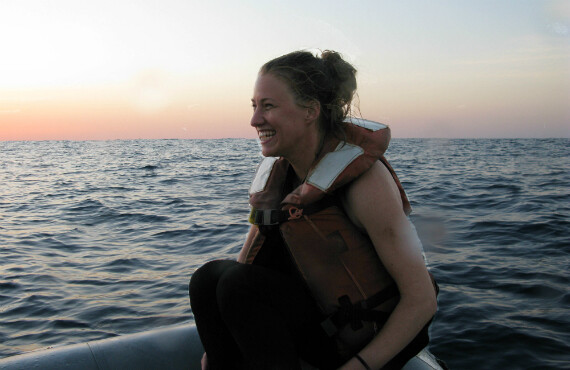Penn Physicist Alison Sweeney Receives 2014 Packard Fellowship in Science and Engineering
The David and Lucile Packard Foundation announced Wednesday that Alison Sweeney, an assistant professor of physics and astronomy at the University of Pennsylvania, will receive a 2014 Packard Fellowship for Science and Engineering.
Sweeney is one of the 18 innovative early-career scientists and engineers who will receive a grant of $875,000 over five years to pursue their research. The fellowship is designed with minimal constraints on how the funding is used, giving researchers the freedom to think big and look at complex issues with a fresh perspective.
Despite her appointment in the School of Arts & Sciences’ Department of Physics and Astronomy, Sweeney was trained as a biologist. Her research involves studying sea creatures that exhibit living photonic structures, or cells that can manipulate light for a variety of purposes. Responsible for these animals’ shifting, iridescent coloration, these cells provide a distinct survival advantage in attracting mates or hiding from predators.
Most recently, however, Sweeney has shown how these structures allow giant clams to function as efficient living greenhouses, filtering sunlight into the optimal wavelengths for growing nutritious algae inside their bodies.
Learning how these structures assemble themselves has implications for designing new light-harvesting materials. Such an approach typifies Sweeney’s role in the School of Arts & Sciences’ evolution cluster, which brings together scholars from across departments to study different facets of this core scientific concept.
“Alison epitomizes the culture of innovation Penn strives for,” Penn President Amy Gutmann said. “Not only does she integrate insights from biology, physics and materials science, she collaborates across disciplines, departments and schools to consider problems from bold new angles. To enlist giant clams on a tropical reef in our quest for alternative energy solutions takes a special kind of scientist, one that we are proud to have at Penn and to have recognized by the Packard Foundation.”
The Packard Foundation established the Fellowships program in 1988 to provide early-career scientists with flexible funding and the freedom to take risks and explore new frontiers in their fields. Each year, the Foundation invites 50 universities to nominate two faculty members for consideration. The Packard Fellowships Advisory Panel, a group of 12 internationally-recognized scientists and engineers, evaluates the nominations and recommends Fellows for approval by the Packard Foundation Board of Trustees.
“The Packard Fellowships are an investment in an elite group of scientists and engineers who have demonstrated vision for the future of their fields and for the betterment of our society,” said Lynn Orr, Keleen and Carlton Beal Professor at Stanford University, and chairman of the Packard Fellowships Advisory Panel. “Through the Fellowships program, we are able to provide these talented individuals with the tools and resources they need to take risks, explore new frontiers and follow uncharted paths.”
Sweeney’s research into the self-assembly of photonic structures has also earned her a Sloan Fellowship, a Kaufman Foundation Award and a National Science Foundation INSPIRE grant. The INSPIRE program supports “bold, exceptional” research that does not conform to the mold of projects that more easily secure funding. It will enable a collaboration with School of Engineering & Applied Science Professor Shu Yang in which they will develop artificial versions of the iridescent cells that help the clams turn sunlight into energy.








